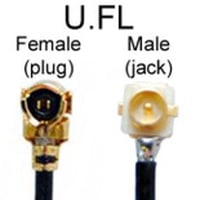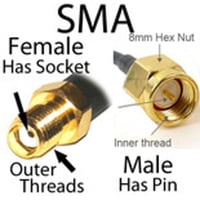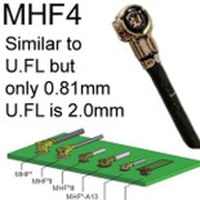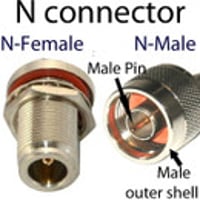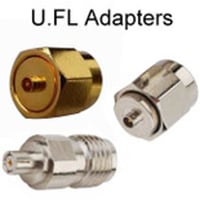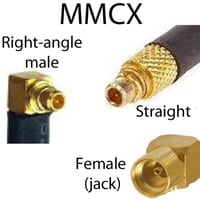U.FL Cables & Adapters
U.FL Cables: Widest selection: Options for all coax types
See list of all of our articles about U.FL cables and connectors.
Our UFL cables' consistently low broadband VSWR range of frequency band compatibility (from 0GHz to 11 GHz)and 50 Ohms impedance matching, makes them suitable for all the following applications:
- All WiFi standards: 2.4GHz or 5GHz applications: Wi-Fi 6, WiFi 6E, 802.11AX, 802.11AC, 802.11N, 802.11G, 802.11B,802.11A,
- Cellular Wireless LTE / 4G,LTEm, GSM / 3G WiMax, 5G
- IOT (Internet of Things) wireless protocols: Bluetooth, ZigBee, LoRa, M2M, RFID, NB-IoT.
We offer five options of thickness of cable for U.FL cables: All five have an impedance of 50 Ohm - compatible with all typical wireless applications:
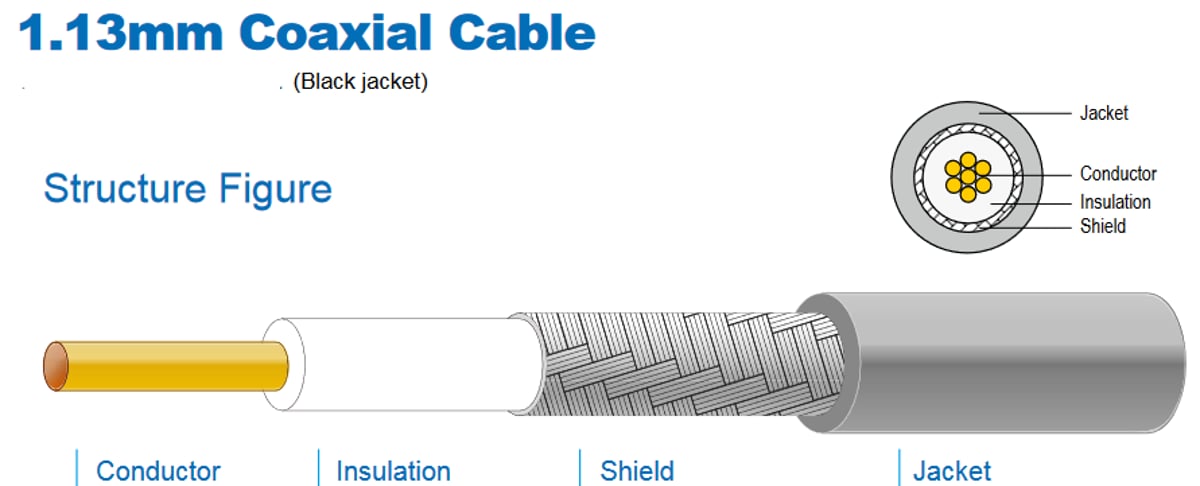 [1] 1.13mm mini-coaxial cable (50 Ohm): This is a very thin and flexible cable, with a black jacket. When connecting U.FL connector to a jack on a miniPCI card or board, sometimes the tight space requires the use of 1.13mm cable, because it is very thin and flexible: It is not always necessary to use 1.13mm cable, but on occasion it is necessary to use 1.13mm cable, to prevent the U.FL connector from popping off the U.FL jack.
[1] 1.13mm mini-coaxial cable (50 Ohm): This is a very thin and flexible cable, with a black jacket. When connecting U.FL connector to a jack on a miniPCI card or board, sometimes the tight space requires the use of 1.13mm cable, because it is very thin and flexible: It is not always necessary to use 1.13mm cable, but on occasion it is necessary to use 1.13mm cable, to prevent the U.FL connector from popping off the U.FL jack.
[2] 1.32mm mini-coaxial cable (50 Ohm): This is very thin and flexible, is double-shielded for lower signal loss than 1.13mm, and has a black jacket. The key difference between 1.13mm cable and 1.32mm is that the tin plated, copper wire braided, outer conductor is a single shield of braiding in 1.13mm coax and is double-braided in 1.32mm coax. The double braiding in 1.32mm cable reduces signal loss (attenuation), and thereby provides greater performance. The first and second shield layers in 1.32mm coax cable may also be made from silver covered copper braid.
[3] 1.37mm mini: If you want us to provide your U.FL cables with 1.32mm coax, please contact us for a special order.
[4] RG174: This is a low-loss coax option for U.FL (which is too large for MHF4 or W.FL). RG174 is about 3mm diameter (vs 4mm for 100-series) and is not double shielded. It's 2.65X thicker than 1.13mm but it is very flexible/easily bendable coax. It has a black jacket. This cable has much lower signal loss (attenuation) per meter than 1.13mm, which translates into better performance. Cable is equivalent to LMR-100 in thickness. Since the LMR-100 equivalent coax has lower signal loss: If this cable works for you without the U.FL connectors popping off the jacks, then this thicker coax is the better solution. You can use a hot glue gun to secure the jack onto the PCB, in which case, of course, the thicker cable will not be a problem: This is the best way.
We can make special orders of U.FL cables with 1.32mm coax, 1.37mm, RG174 or RG178 or 1.13mm cable, for better flexibility. 1.32mm is very thin and flexible, like 1.13 coax.
[5] U.FL Connectors' Gender is confusing because a U.FL jack, such as you would find on a miniPCI male wireless card or board is the male U.FL connector. So U.FL gender is an exception to the rule for most other RF connector types, for which "jack" is synonymous with "female connector." See the photo at the top-left of the page: U.FL male and female.
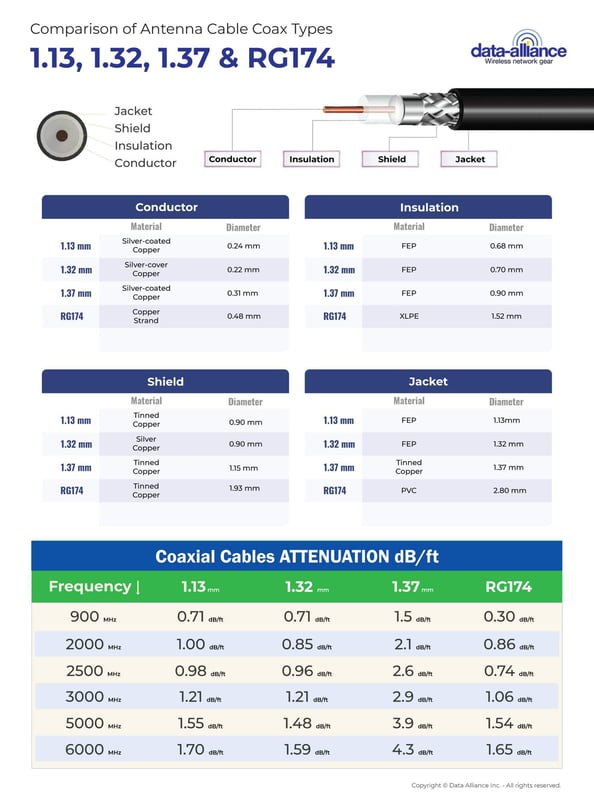
UFL is a tiny radio frequency connector that is applicable for high frequency signals up to 6GHz band. They have a wide range of applications as antenna cable connectors, most commonly for applications in which space is a key consideration, such as embedded systems, including as the antenna jack on MiniPCI cards and as GPS antenna connectors.
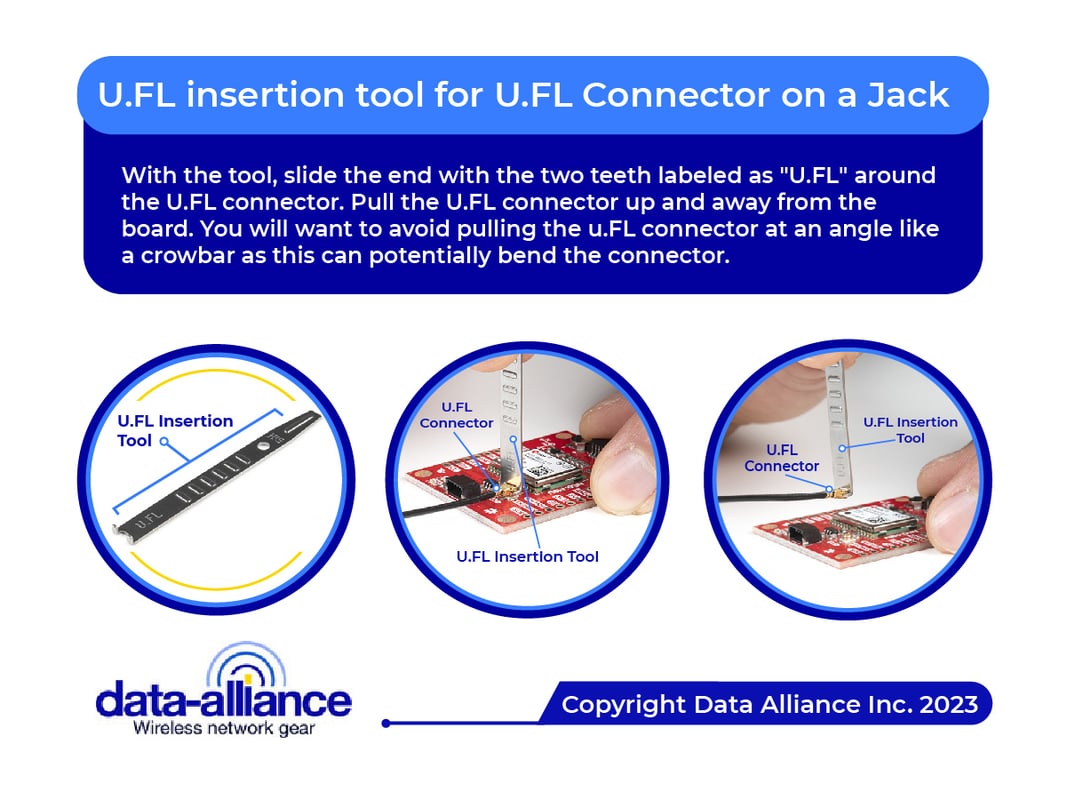
Male UFL connectors are highly rigid, as they need to be embedded directly on to a circuit board. They take only about 9 mm2 in space. Female UFL connectors come as the termination on an antenna cable. They can be used for up to about 30 mating incidences, after which they will have deteriorated or been damaged, and a replacement is required.
U.FL connectors / Antenna cables w/ U.FL connectors
The Hirose U.FL connector is a type of radio frequency (RF) connector used to connect coaxial cables. It is the smallest RF connector on the market.
- U.FL (sometimes called UMCC) is rated up to 6Ghz.
A U.FL connection stands only 2.5mm high when mated. The small profile and right-angle joint make it ideal for applications where space is at a premium - FOR EXAMPLE: to connect a WiFi antenna to a miniPCI card inside a slimline laptop.
- A U.FL cable may also connect to a GPS antenna or a Bluetooth Beacon.
Befitting a part that might end up in the chassis of a laptop, this connection is meant to stay put when mated. Snapping and unsnapping it several times will cause the female connector to wear out. It would then need to be replaced, along with the attached coaxial cable.
The male connector is usually soldered directly onto the circuit board as the jack: The jack is small enough to take up as little as 9mm x 9mm of space. The female connector snaps onto the male connector, secured by pressure from the metal snap structure.
A U.FL cable is typically a double-shielded 1.32mm coax. To fit in tight spaces, a thin and flexible 1.13mm coaxial cable may also be used. The largest antenna cable to feature U.FL is the 3mm RG174. Thicker but still flexible, the RG174 coax is not double-shielded and delivers less signal loss than its 1.32mm or 1.13mm counterparts.
The small size of U.FL and MMCX connectors has made them an excellent fit in Internet of Things (IoT) applications since they take up very little space in the cramped cases of small devices, such as Bluetooth beacons.

